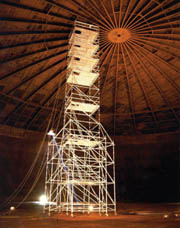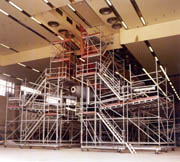

Another definition may add more to how the word competent may be interpreted: "Competent" in relation to a person, means adequately qualified, suitably trained and with sufficient experience to safely perform work without supervision or with only a minimal degree of supervision.
Both of the above definitions are written is such a way that they are relative to the tasks being performed with more complex tasks requiring a person with additional training and experience.
Users of scaffold need to be aware of hazards associated with working on a scaffold, including falling, unsafe access, falling objects, electrical hazards and scaffold collapse.
Erectors and dismantlers of scaffold systems also need to know the regulations, codes and company policies that apply in the jurisdiction they are working in and be familiar with manufacturer's instructions and specifications for the scaffold system being used.
At the crux of safety in general is the company safety program and training. For safety programs to be effective, they must be endorsed by senior management and contain the following elements:
• Health and safety policy
• Hazard assessment
• Safe work practices
• Safe job procedures
• Company rules
• Personal protective equipment policy
• Maintenance policy
• Training policy
• Inspection policy
• Investigation policy
• Emergency preparedness
• Statistics and records
Individual elements may be combined in some safety programs but should be kept up to date and independently audited from time to time to ensure the safety program is implemented properly and is working effectively.
Training should both be general and job specific. General training includes orientation, emergency response, reporting hazards, a review of the company safety policies regarding PPE and specific rules the company may have. Job specific training would cover safe work practices and job procedures for the tasks being performed.
Applying this to scaffold safety, an orientation needs to include hazard awareness and prevention training covering fall hazards, access, falling object protection, electrocution and scaffold collapse. Job specific training may include code and regulation training for the jurisdiction, a job site survey, specific training for the type of scaffold being used, safe work practices and specific job procedures for the job.
The training programs offered by the Scaffold Industry Association for scaffold cover both the general and specific training needs. SIA's Competent Person Training programs are available for frame scaffold, system scaffold and tube-and-clamp (coupler) scaffold. The training provided covers the knowledge, skills and attitudes that a worker needs to have to perform there job effectively and safely.
As the employee gains experience they can advance their training eventually becoming a journeyman scaffold erector. The SIA's Safety Training for Suspended Scaffold correspondence course continues to be the industry standard for suspended scaffold training.
The SIA has produced Codes of Safe Practice for the erection of supported scaffold and suspended scaffold which when posted on the job site help reinforce scaffold safe work practices.
Providing safety information, training, and regularly reinforcing safe work practices with tool box talks and regular safety meeting help cultivate safety attitude among workers providing a safer work site and preventing accidents.
For more information regarding the SIA and the training programs offered visit www.scaffold.org or call (602) 257-1144.

Report Abusive Comment